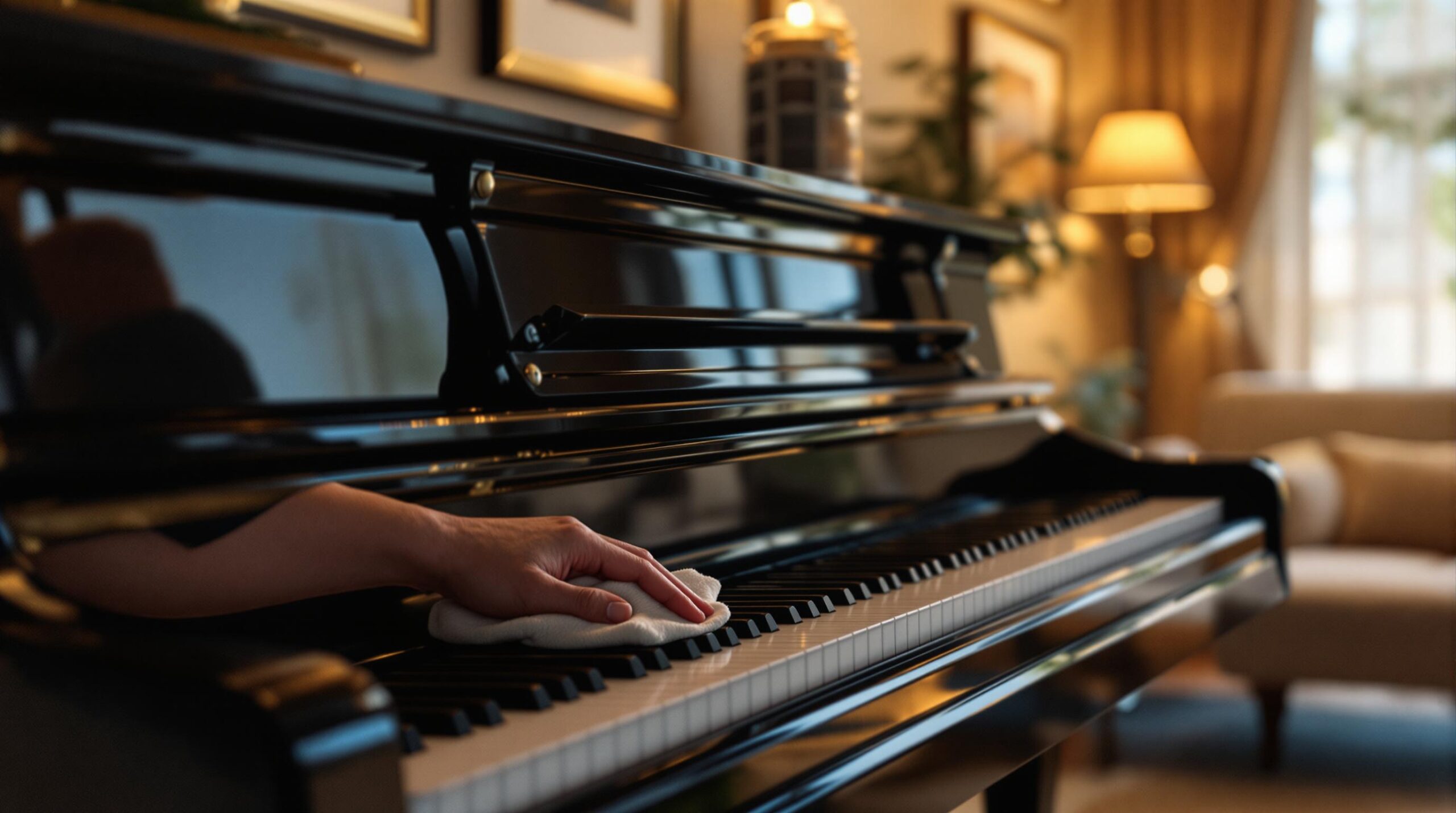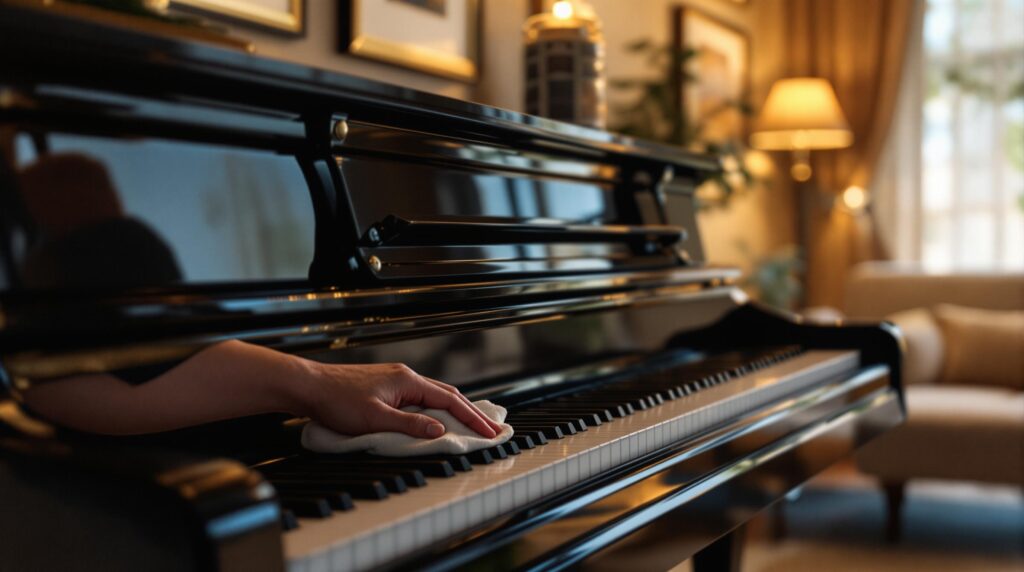
Want to keep your black piano looking flawless? Black piano finishes are stunning but prone to dust, fingerprints, and scratches. Here’s a quick guide to protect and maintain its shine:
- Use microfiber cloths for dusting and cleaning – avoid rough fabrics.
- Stick to piano-safe cleaning solutions like distilled water or professional products. Never use household cleaners like Windex or furniture polish.
- Dust daily to prevent scratches.
- Follow the wood grain when wiping to avoid streaks.
- Clean fingerprints carefully with a damp microfiber cloth and dry immediately.
- Polish sparingly using piano-specific polish for extra shine.
- Protect your piano with a quality cover and maintain stable humidity and temperature.
Essential Tips for Safely Cleaning Your Piano’s Delicate Finish and Keys
Required Cleaning Tools and Products
To keep your piano looking its best, you’ll need the right tools and cleaning products. Here’s what to gather:
Cleaning Tools
- Microfiber cloths: Use separate cloths for dusting, cleaning, and polishing to avoid spreading dirt or residue.
- Soft-bristled piano duster or feather duster: These are gentle enough to remove loose dust without scratching.
- Clean spray bottle: Helps evenly apply cleaning solutions.
Cleaning Products
- Distilled water: Prevents mineral deposits that can occur with tap water.
- Piano-specific cleaning solutions: Designed to clean without causing damage.
- Professional piano polish: Ideal for high-gloss finishes if you want extra shine.
Safe Cleaning Options vs. What to Avoid
| Item Type | Safe Options | Avoid |
|---|---|---|
| Cloths | Microfiber or 100% cotton | Paper towels, rough fabrics |
| Cleaning Solutions | Distilled water, piano-specific cleaners | All-purpose cleaners, furniture polish |
| Dusters | Feather or microfiber dusters | Synthetic or treated dusters |
Safety Tips
- Always test cleaning products on a hidden area first.
- Keep your supplies organized to prevent spills.
- Replace microfiber cloths when they show signs of wear.
- Avoid using household or alcohol-based cleaners, as they can harm your piano’s finish.
If you’re looking for professional-grade supplies, check out Cooper Piano‘s curated selection.
1. Clean with Microfiber Cloths Only
Start by picking the right cleaning tool. Microfiber cloths are ideal because their soft, non-abrasive fibers effectively trap dust without causing scratches.
When cleaning, use smooth, steady motions – there’s no need to press too hard. Pair the cloth with a suitable cleaning solution to protect the surface’s finish.
2. Pick the Right Cleaning Solution
When it comes to cleaning high-gloss pianos, it’s important to use products that are safe for their delicate finish. Stay away from common household cleaners like Windex, furniture polish, or all-purpose cleaners, as they can contain harsh chemicals that might harm the surface.
Here are some safe cleaning choices:
- Distilled water with a few drops of mild dish soap: Perfect for light cleaning.
- Professional piano cleaning solutions: Brands like Yamaha or Steinway offer products specifically made for piano finishes.
- Plain distilled water: Ideal for light cleaning tasks, but avoid using tap water, which may leave mineral deposits.
What to Avoid
It’s equally important to steer clear of these:
- Cleaners with alcohol, ammonia, or silicone.
- Abrasive products or polishes.
- Oil-based furniture cleaners.
- Aerosol sprays of any kind.
For best results, always apply the cleaning solution to a microfiber cloth first – never directly onto the piano. Before cleaning the entire surface, test the solution on a small, hidden area to make sure it doesn’t cause damage.
If you encounter stubborn stains or marks, it’s better to get help from a professional piano technician. Many piano dealers, like Cooper Piano, provide specialized cleaning services and can recommend the right products for your piano’s finish.
3. Remove Dust Daily
Dusting your piano every day helps prevent tiny scratches on its glossy finish. Grab a clean microfiber cloth and gently wipe the surface to keep it looking pristine. Up next, discover how to pick the best cleaning solution to maintain your piano’s shine.
sbb-itb-b8bc1ab
4. Follow the Wood Grain Pattern
When cleaning a black piano finish, the direction of your wiping motion matters. Always wipe along the wood grain to avoid scratches and streaks.
The best technique? Use gentle, straight strokes that align with the grain. This reduces resistance and helps keep the surface smooth and scratch-free.
Here’s how to do it right:
- Spot the grain direction: Under good lighting, examine your piano’s surface. You’ll usually find the grain running horizontally on the fallboard (key cover) and vertically on the sides.
- Wipe with long, even strokes: Move your cloth parallel to the grain without stopping mid-motion.
- Apply light, steady pressure: Keep your touch gentle and consistent for the best results.
Avoid circular motions or wiping across the grain. These actions can leave tiny scratches that reflect light unevenly, making the finish look dull or uneven. Since different parts of the piano may have different grain patterns, take a moment to check before you start cleaning to preserve that sleek, polished look.
5. Clean Fingerprints Properly
Fingerprints can stand out on black piano finishes, and cleaning them requires care to avoid harming the surface.
- Start with a Check: Examine the area under good lighting to see how noticeable the fingerprints are.
- Try a Dry Cloth First: Begin with a clean, dry microfiber cloth to gently wipe the surface.
- Use Cleaner If Needed: If the marks persist, lightly dampen the microfiber cloth with a piano-safe cleaning solution – never apply the cleaner directly to the piano.
Here’s a simple step-by-step:
- Lightly dampen part of the microfiber cloth with the cleaner.
- Test it on an inconspicuous area first to ensure it’s safe.
- Wipe using gentle strokes, following the grain or finish pattern.
- Quickly buff dry with a clean, dry section of the cloth to avoid streaks.
This approach helps remove fingerprints while protecting the finish.
For stubborn marks, it’s best to contact a professional piano technician. Experts, like those at Cooper Piano, can safely restore your piano’s polished look without risking damage.
To keep your piano looking its best, keep a microfiber cloth handy for quick touch-ups. Wiping off fingerprints right after they appear can help maintain that sleek, elegant finish.
6. Use Polish Carefully
Polishing your piano can boost its shine and keep it looking stunning, but it must be done with care to avoid damaging the finish. Using the wrong products or techniques can do more harm than good.
Polish your piano only when its shine starts to fade. Always opt for a polish specifically designed for piano finishes, and steer clear of furniture or all-purpose cleaners, as they often contain harsh chemicals that can harm the surface.
Here’s a simple method to follow:
- Prepare the Surface: Clean the piano thoroughly to remove dust and debris before polishing.
- Test First: Apply a small amount of polish to a hidden area to ensure it won’t damage the finish.
- Apply Sparingly: Use a clean microfiber cloth with a small amount of polish. Avoid applying the polish directly to the piano.
- Follow the Wood Grain: Gently polish in the direction of the wood grain, using overlapping strokes.
- Buff Immediately: Quickly buff the surface with a dry microfiber cloth to enhance the shine and prevent streaks.
If you own a high-value or antique piano, it’s best to leave polishing to professionals to ensure the finish remains intact.
7. Keep Your Piano Protected
After cleaning and polishing your piano, the next step is making sure its finish stays in top condition. A little effort to protect it now can prevent damage and keep it looking great for years.
Start with a quality piano cover to shield against dust, sunlight, and scratches. Look for covers made of breathable materials like cotton or microfiber, as these help avoid moisture buildup. Make sure the cover fits snugly and complements your piano’s design.
In addition to using a cover, it’s important to manage the room’s environment. Use a hygrometer to monitor humidity and keep the temperature consistent. This can help prevent damage caused by fluctuating conditions.
Here are some common environmental risks and how to address them:
| Factor | Impact on Finish | How to Prevent It |
|---|---|---|
| Direct Sunlight | Causes fading | Keep the piano away from windows or use UV-blocking curtains |
| Heat Sources | Can warp or damage finish | Maintain a stable room temperature |
| High Humidity | Leads to water spots | Use a dehumidifier when needed |
| Low Humidity | May cause cracking | Use a humidifier to balance moisture levels |
For the best results, position your piano away from windows, vents, and exterior walls. Also, avoid placing it near radiators, heating vents, or fireplaces, as heat exposure can lead to serious damage. Taking these precautions will help preserve your piano’s finish and overall condition.
Conclusion
Keeping a black piano finish in top shape takes regular attention. By following the cleaning tips in this guide, you can protect your piano’s surface for years to come. The trick is to use the proper tools and suitable cleaning products.
Daily dusting and promptly wiping away fingerprints help avoid buildup. Cleaning along the wood grain, using polish sparingly, and managing the surrounding environment all contribute to maintaining the finish.
For more serious concerns or professional care, consider reaching out to experienced piano technicians. For example, Cooper Piano (https://cooperpiano.com) provides specialized cleaning services tailored to pianos.
Why Proper Care Matters:
| Benefit | Impact |
|---|---|
| Longer Finish Life | Prevents early wear and damage |
| Maintained Value | Keeps the piano looking beautiful and valuable |
| Optimal Performance | Ensures the piano looks and works its best |
| Fewer Repairs | Reduces the need for expensive refinishing |

